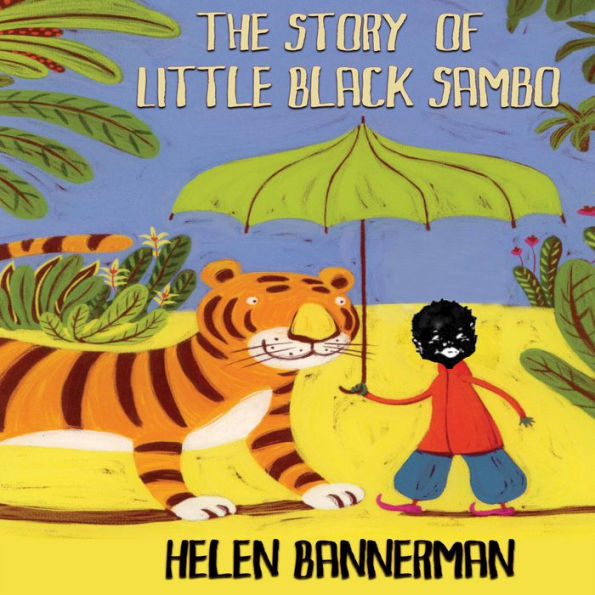Publishers Weekly
In this edition of Bannerman's story, first published in 1899, a long afterword from the publisher spells out its checkered past. But while the text remains nearly precisely the way Bannerman told it, Bing's (Casey at the Bat) light-infused illustrations focus on the heroic boy's courage and ingenuity as he outwits a series of tigers in the forests of India. One of the giant striped foes lurks in the grass on the title page, and the opening spread depicts Black Mumbo and Black Jumbo, the boy's parents, returning from the marketplace among buildings of onion-shaped domes and the ruins of exotic columns. They present him with the "beautiful little Red Coat,... Blue Trousers,... Green Umbrella... and lovely little Pair of Purple Shoes with Crimson Soles and Crimson Linings"; he will use these to bargain with the threatening tigers, before reclaiming them while the tigers fight to prove who looks grandest in his vestments. Unlike the vain tigers of Marcellino's The Story of Little Babaji or the somewhat simple-minded tigers, as characterized by Jerry Pinkney in Julius Lester's Sam and the Tigers, Bing's villains are ferocious, often towering above Little Black Sambo or tugging at the boy's pants with bared teeth. Still, Little Black Sambo maintains his composure and never seems frightened. The mood here may be more somber than Marcellino's or Lester's versions, but the hero looks triumphant as he walks away in his new outfit, none the worse for his trade. Ages 5-up. (Dec.) Copyright 2003 Reed Business Information.
School Library Journal
PreS-Gr 4-Despite the controversy surrounding Bannerman's racially insensitive choice of names and style of illustration for her 1899 book, Little Black Sambo perseveres in print and in the memories of adults who encountered the tale as children. Whereas Julius Lester (Sam and the Tigers [Dial, 1996]) casts Sam as a hero of the American South, and Fred Marcellino places The Story of Little Babaji (HarperCollins, 1996) in India, Bing affirms Bannerman's text and the incongruities inherent in fantasy. His African child lives in India where those infamous tigers want to eat him up-until each receives a portion of his new outfit. This is vintage Bing. The book has a weathered look, including the illusion of ripped seams and folded, yellowed pages. The danger, however, is palpable from the outset: the linen and gilt cover bears the deep, jagged imprint of a claw. Each double-page painting is framed in black and infused with golden light. The glow emanates from the sun, the tigers, the domes-foreshadowing the brilliance of that "lovely melted butter." Pen and ink are applied meticulously to skin, fur, and landscape, creating a rich overall texture and depth; the areas of unadulterated color provide the magical aura. Endpapers decorated with newspaper clippings, postcards, maps, shadow puppets, and other realia provide an in-depth history of the story and the particulars of this version. Some adults will no doubt continue to debate the use of Sambo. Children will be dazzled and delighted by the turn of events depicted here.-Wendy Lukehart, Washington DC Public Library Copyright 2003 Reed Business Information.
Kirkus Reviews
The most controversial children's picture book in history is richly resurrected with truly sumptuous illustrations in a gorgeous oversized format. Bing retains Bannerman's original text and names, but replaces the stereotypical characteristics with a handsome, tawny-skinned Sambo, and dresses Black Mumbo in a sari and Black Jumbo in a turban. In a note on the front endpapers, Bing relates how he worked for 20 years to illustrate his favorite childhood story. Amid the beautiful, etched-line textures, sun-kissed colors, and lush greenery, the magnificent tigers not only steal Sambo's clothes but also steal the visual show. Fascinating focal points create dramatic perspectives (a tiger viewed between Sambo's knees) and cinematic close-ups. The bordered spreads appear as if on parchment and end-page collages intriguingly display old postcards, maps, and items of the times. A lengthy note by the publisher on the story's history and publication provides important context. Exceptional in every detail: a classic story respectfully revitalized to a new grandeur-one it deserves. Simply superb. (Picture book. 3-7)




